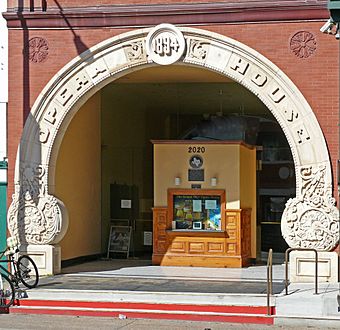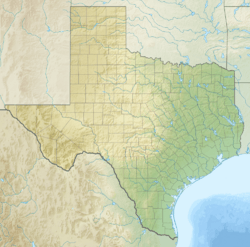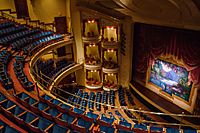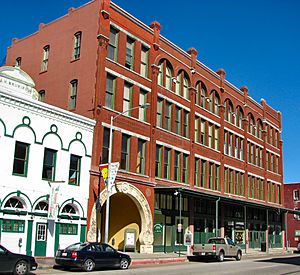Grand 1894 Opera House facts for kids
|
Grand Opera House
|
|

Opera House entrance in 2012
|
|
| Location | 2020 Postoffice St. (Ave. E), Galveston, Texas |
|---|---|
| Area | 1 acre (0.40 ha) |
| Built | 1895 |
| Built by | Barnes & Palliser |
| Architect | Frank Cox |
| Architectural style | Romanesque |
| NRHP reference No. | 74002071 |
Quick facts for kids Significant dates |
|
| Added to NRHP | January 2, 1974 |
The Grand 1894 Opera House in Galveston, Texas is a special place where people go to watch live shows. It is run by a group that doesn't make a profit, focusing instead on the arts. This beautiful building is designed in a style called Romanesque Revival. It is located in Galveston's Historic Downtown Cultural Arts District. In 1993, the Texas Legislature officially named it "The Official Opera House of Texas." It has enough seats for 1,040 people.
Contents
History of The Grand Opera House
The Grand Opera House first opened its doors on January 3, 1895. A man named Henry Greenwall helped raise $100,000 to build it. The very first show was a play called The Daughters of Eve.
Surviving Storms and Changes
The Grand Opera House has stood strong through many big hurricanes. These include the terrible Galveston Hurricane of 1900 and Hurricane Ike. Even when these powerful storms hit, the building survived.
At first, The Grand was a popular place for live plays and performances. Later, it became a movie theater. In 1974, the movie theater closed. A group called the Galveston County Cultural Arts Council bought it. They worked hard to turn it back into a live theater. Many volunteers and private groups helped to fix it up and make it beautiful again.
Becoming a Historic Landmark
Because of its importance, The Grand Opera House was added to the National Register of Historic Places in 1974. This means it is recognized as a special historic building. The Arts Council owned it until 1986. Then, it became its own organization called 1894, Inc.
When Hurricane Ike hit Galveston Island in September 2008, The Grand was damaged. But workers quickly repaired it in just 92 days. It reopened on January 3, 2009, which was its 114th birthday!
Famous Performers at The Grand
Many famous people have performed at The Grand Opera House over the years. Here are some of them:
- Maude Adams
- Gracie Allen
- Paul Anka
- The Beach Boys
- Tony Bennett
- Sarah Bernhardt
- William Jennings Bryan
- George Burns
- Ray Charles
- George M. Cohan
- Larry Gatlin and the Gatlin Brothers
- Eydie Gormé
- Helen Hayes
- Lionel Hampton
- Hal Holbrook
- Marilyn Horne
- James Earl Jones
- Dorothy Kirsten
- Steve Lawrence
- Cloris Leachman
- Lyle Lovett
- The Marx Brothers
- Johnny Mathis
- Maureen McGovern
- Liza Minnelli
- Madame Modjeska
- Willie Nelson
- The Oak Ridge Boys
- Ignace Paderewski
- Anna Pavlova
- Itzhak Perlman
- Bernadette Peters
- Lillian Russell
- Otis Skinner
- John Philip Sousa
- Tommy Tune
- Vienna Choir Boys
Special Performances and Filming
The Grand has also hosted the very first performances of some plays. These include Red White & Tuna and Tuna Does Vegas. These funny plays were created by Jaston Williams and Joe Sears. Another play, ANN, about Texas Governor Ann Richards, also had its first performance here.
The music video for the Mötley Crüe song "Without You" was filmed at The Grand. This happened on January 15, 1990.
Architecture and Design
When The Grand opened in 1895, its stage was huge. It was the largest in Texas and one of the biggest in the whole country. Even today, if someone whispers on stage, you can hear it without a microphone. No seat is more than 70 feet away from the stage.
Building Features
The front of the building is made of red stone, brick, and terra cotta. The large glass doors have a beautiful carved stone arch around them. Inside, the box office, where you buy tickets, is made of glass.
The carpet inside has a historic pattern. It matches the colors found in the decorative curtain and the rose and scroll designs on the ceiling. The floors are made of shiny marble tiles. The walls have wood panels called wainscot. The stair railings are made of strong, red-heart pine wood. A large bronze statue of a woman holding a torch stands at the bottom of the main staircase.
Inside the theater, red velvet curtains frame the stage. There are also eight special opera boxes. The chairs are covered in soft blue velour. The stage curtain shows a picture called “Sappho and Companions.” This picture is a copy of the original design by the architect, Frank Cox.
See also





